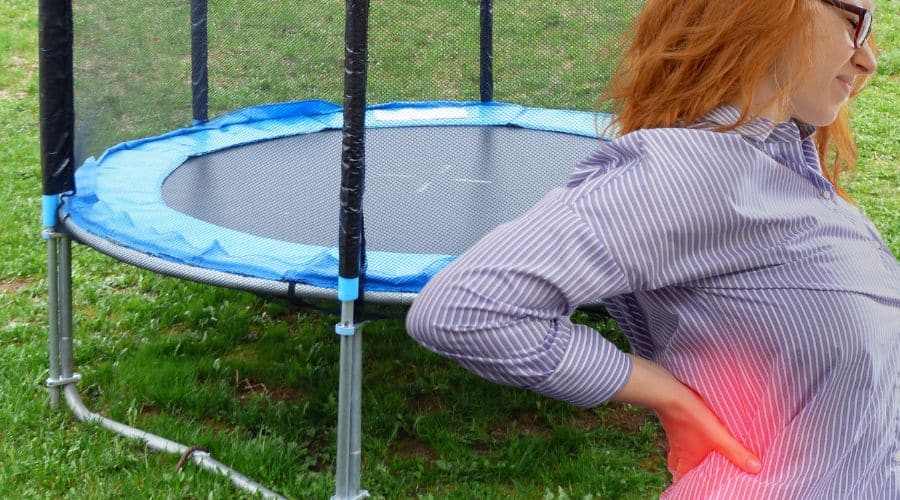Are trampolines bad for your back? It’s reasonable to assume that jumping is not good for your back since it’s such a sudden motion. However, studies have shown that trampoline usage is a low-impact exercise that does not lead to spinal injury. Read on to learn the effects of a trampoline on the back and how to treat back injuries.
Is It Harmful To Your Back To Use A Trampoline?
Depending on one’s perspective, this question may be answered either positively or negatively. For example, when you bounce on a rebounder, your back muscles automatically contract to help prevent any damage to your spine from the impact.
Straining your muscles would only worsen your condition if you already have disc problems such as degenerative disc disease or disk herniation. Your back will suffer significantly more after jumping.
However, there are times when bouncing on a rebounder might help with back discomfort. People with spondylolisthesis, a disorder that causes the joints and soft tissues in your spine to weaken or even completely tear, are a good candidate for trampolining as a means of rehabilitation.
Exercises performed on it may help bolster the ligaments’ central pillars, which in turn helps to maintain the ligaments’ health.
Actually, trampolining has both pros and cons. It has the potential to exacerbate or alleviate pain. Thus, we advise people with back problems to get a doctor’s approval first.
Can A Trampoline Cause Back Pain? 3 Possible Reasons
Bouncing on a trampoline may cause back discomfort in several different ways:
- They might aggravate existing medical conditions.
- The risk of muscular strain and injury increases if you will not warm up beforehand.
- The worst situation is a fall from a rebounder, resulting in a significant spinal cord injury.
But if you take the time to warm up and leap with awareness, you should be OK. In short, you should take all precautions to avoid injuries and respond immediately to any sign of issue of increasing concern.
You also might be interested in: Can You Jump On A Trampoline While Pregnant 2nd Trimester
How to Treat Trampoline Back Injuries?
If rebounder usage has resulted in back discomfort, a variety of solutions are available to help you feel better and return to bouncing.
1. Checking the Curvature of the Spinal Cord
First and foremost, you should check for the curvature of the spinal cord. In addition, you should check to determine whether the back pain is localized either to the side or if it can be felt on both. Additionally, you need to pinpoint if the discomfort is mostly in your lower, mid, or top back.
2. Taking Hot showers For Back Pain
Hot showers are the go-to remedy for relieving back pain for most people. The stream of water needs to be explicitly directed toward the sore spot. Simply said, hot water does wonders for relieving back pain and soothing muscle soreness.
3. Stretching and Straightening Exercises
You may perform some stretching and straightening exercises at a moderate intensity. Caution is required, though, since inadvertently causing more harm to your back can be the unintended result of this exercise.
4. Back Massage
You can also get a back massage to loosen up those knotted muscles.
Note: If these measures don’t improve your health, it may be time to consult a professional who can prescribe medicine or suggest other treatments.
Effects of a Trampoline on Back
Low-impact activities, such as bouncing on it, are safe for the back. Jumping on a rebounder has so many advantages, including enhancing back mobility. In addition, orthopaedic physicians highly recommend Workouts on a mini rebounder to maintain a healthy weight and ward off back issues.
Related: Best Mini Trampolines For Seniors
Muscle Strengthening
Trampoline bouncing is a great way to do both if you want to enhance your stability and safeguard your spine from shocks. Every part of your body will feel the same amount of pressure from the collision.
Bolstering Muscles and Bones
As a result, rebounder jumping encourages a holistic perspective on fitness. A trampoline may prevent harm caused by falls on hard surfaces by absorbing the impact. It has a double benefit, bolstering both muscle and bone.
Thirty minutes of bouncing is equivalent to an hour of jogging as just a vigorous exercise. While the opposition to gravity experienced when rebounding is minimal, it does aid in strengthening the body’s cells. It is believed that immune cells may eliminate pathogens, including bacteria and viruses, as well as cancer cells. Therefore, it is suggested that you activate them.
Bottom Line
In a nutshell, trampoline jumping is helpful and harmless, provided that the correct workouts are performed, and certain health issues are avoided. However, you shouldn’t give up hope even if you harm yourself. It’s as simple as identifying the root of the discomfort and implementing the solutions we discussed. What are your thoughts on jumping on a trampoline? Let us know in the comments section.




